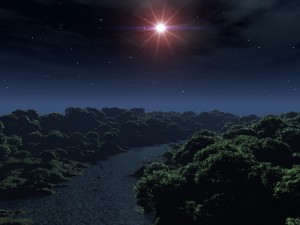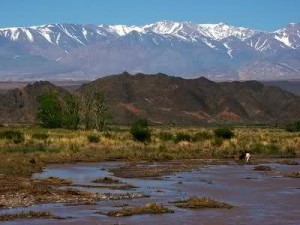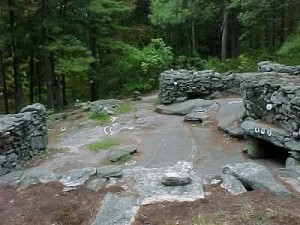1. Mexico’s Zone of Silence.
by Scott Corrales
There exist a number of “accursed sites” on the surface of our planet. Some of these locations are the sites of gravitational or atmospheric disturbances that still remain unexplained by twentieth century science. Such anomalous areas possess properties which interfere sporadically with humans and their equipment. One area worthy of mention surrounds the Mediterranean island of Elba (famous for being Napoleon’s first place of exile), and is the bane of maritime aviation in the Mediterranean; another spot is Mt. Stredohori in Czechoslovakia, where an unknown force drains car engines of power throughout the length of a 75-foot stretch of road.
However, we need not travel so far to encounter a part of the world that is even more perplexing than these others, although it remains little known to most people: Mexico’s mysterious, magical zona del silencio–the Zone of Silence, just four hundred miles away from El Paso, Texas. Deserts are often considered to be mysterious enough without the added weirdness that this patch of earth some four hundred miles from El Paso has to offer. It is a place which gobbles up radio and TV signals, and which has of late been associated with the UFO phenomenon.According to Dr. Santiago Garcia, there has been an awareness of the unusual properties of the area since the mid-nineteenth century, when farmers trying to eke out a living in the forbidding environment became aware of the “hot pebbles” which routinely fell to earth from the clear sky. In the 1930s, Francisco Sarabia, an aviator from the northern Mexican state of Coahuila, reported that his radio had mysteriously ceased to function, earning him the distinction of being the Zone of Silence’s first victim.
(Click Here To Watch Video About The Zone of Silence)
Read More Here
2. The Eltanin Enigma
By Peter Brookesmith
In 1964, an Antarctic research vessel photographed a mysterious and unidentifiable object on the sea bed. In the first of a two-part investigation, Peter Brookesmith explains how the ‘Eltanin antenna’ generated a soap opera from another Universe.
Whitley Strieber, whose 1987 book Communion did so much to make intergalactic grey dwarves a subject of dinner-table chatter in even the best-regulated households, is clearly a man prepared to entertain many rare and unusual ideas. Visitors to his website may sample the kinds of things that fascinate Strieber, and will find this cogitation:
Between 1962 and 1979 the NSF [National Science Foundation] Polar Research Vessel Eltanin surveyed Antarctic waters, studying the ocean and ocean bottom. In 1964, the ship photographed an unusual object at a depth of 13,500 feet [4,115m]. At the time, there was no submarine that could have carried a piece of technology to this depth.
The object appears to be a pole rising from the ocean floor with twelve spokes radiating from it, each ending in a sphere. The spokes are at 15 degree angles to each other. It is located approximately 1,000 miles [1,600km] south [sic] of Cape Horn, beneath some of the most inhospitable seas in the world.
There exists the possibility that it is an antenna or other scientific instrument that was lost by an early research vessel, but once again, this would appear to be a very forced explanation. It seems unlikely that an object could drop through [over] three miles of ocean, and anchor itself on the bottom.
3. What Lies at the Bottom of the [Oak Island] Money Pit?
by Bradley Keyes
One summer day in 1795 Daniel McGinnis, then a teenager, was wandering about Oak Island, Nova Scotia (see Geography) when he came across a curious circular depression in the ground. Standing over this depression was a tree whose branches had been cut in a way which looked like it had been used as a pulley. Having heard tales of pirates in the area he decided to return home to get friends and return later to investigate the hole.
Over the next several days McGinnis, along with friends John Smith and Anthony Vaughan, worked the hole. What they found astonished them. Two feet below the surface they came across of layer of flagstones covering the pit. At 10 feet down they ran into a layer of oak logs spanning the pit. Again at 20 feet and 30 feet they found the same thing, a layer of logs. Not being able to continue alone from here, they went home, but with plans of returning to search more.
It took the three discoverers 8 years, but they did return. Along with The Onslow Company, formed for the purpose of the search, they began digging again. They quickly got back to 30 foot point that had been reached 8 years ago. They continued down to 90 feet, finding a layer of oak logs at every 10 foot interval. Besides the boards, at 40 feet a layer of charcoal was found, at 50 feet a layer of putty, and at 60 feet a layer of coconut fiber.
At 90 feet one of the most puzzling clues was found – a stone inscribed with mysterious writing.
4. Things That Go Boom In The Night
by Brad Steiger
In Modesto, California, on October 3, 1950, a mystery explosion shattered the night with such violence that a general fire alarm was sounded for fifteen miles around.In Thanet and Margate, England, in the early morning of October 19th , officials reported the “biggest explosion since the war.” Vibrations were felt as far away as Deal, but no one offered an explanation.
On November 10, 1950, a thirty-mile area in the lower St. Lawrence River area, Canada, was vibrated by a mystery blast. Federal transport department officials tried to pin this one on a U.S. Air Force plane with engine trouble that dropped a bomb.
On January 4, 1952, a series of mystery blasts shook Los Angeles and San Diego. The first explosion sounded at 3:33 A.M. in the vicinity of Los Angeles’ International Airport. The second thundered forth from San Diego’s Mission Hills at 8:30 P.M., followed by a third at Point Lorna a half an hour later, and a fourth nearly two hours later in the Chula Vista region.
Police officials stated that their investigation revealed that no explosions had been set off at those times. Scientists selected the old, dependable scapegoat of exploding meteorites, even though none had been reported or observed on that date.
5. Mysterious Tunnels
by Stephen Wagner
There is something fundamentally and primally mysterious about caves and tunnels. Maybe it’s their darkness or the fact that they open into the very body of the Earth. They are invariably the subjects of adolescent adventure stories, such as the Hardy Boys, Nancy Drew mysteries, and R.L. Stine’s books. And they serve as backgrounds in exciting stories directed at older audiences as well, such as Jules Verne’s A Journey to the Center of the Earth and the Indiana Jones films. Tunnels represent the unknown and touch the fears that reside deep in the primitive human subconscious.
I’ve come across several sites on the Web that tell what some believe are true stories of vast underground networks of tunnels. And they are no less mysterious and fantastic than those used as settings in the fictional tales mentioned above. It’s not that the tunnels merely exist and are unknown to most people, it’s what they contain, who built them, and why – and that takes us into the deepest recesses of the unknown.
People who claim to have first- or second-hand knowledge or experience with these tunnels make many astonishing claims: that they contain long-lost cities; that they are inhabited by advanced civilizations – perhaps the descendents of Atlantis; that they are bases for extraterrestrials and their flying saucers; that they are bases for secret government installations. The government no doubt has top-secret military installations deep within mountains and perhaps underground, but this, of course, is the least fantastic of the stories.
6. Mysterious Valleys
There is no shortage of strange or haunted locations on our planet, and Argentina’s Calingasta Valley is definitely among them, located near the town of Barreal in the province of San Juan. Drivers who have to cross this arid region out of necessity have reported seeing a variety of strange lights in the darkness: orbs of yellowish or white energy described as being around the size of a soccer ball which can be mistaken for the lights of a distant, oncoming automobile. Much like the Marfa Lights of Texas, these Argentinean orbs appear and vanish only to reappear further down the road. On some occasions they engage in frantic pursuits of trucks and cars along the road; on others, they stand in the way of traffic, causing understandable consternation.
Journalist Patricio Parente mentions the case of a schoolteacher anxious to return home and, lacking a car, hitched a ride with a truck driver. After the vehicle was on its way, the teacher mentioned that she could see distant lights like small candles, which appeared to be following the truck. But even more alarming than this was the fact that a bigger light had already placed itself above the truck’s cab, endeavoring to slow it down or bring it to a halt, in spite of the driver’s best efforts to maintain speed. Are we dealing with a normal “earthlight” phenomenon or some kind of South American ignis fatuus of the desert, or something stranger?
7. Mystery Hill: America’s Stonehenge?
About 40 miles north of the city of Boston, and about 25 miles inland from the Atlantic Ocean, is what appears to be the greatest, and perhaps oldest, megalithic enigma of North America. Mystery Hill, also known as “America’s Stonehenge”, is a site that has puzzled archaeologists for almost a century.
Running across the 30 acres of hillside are a series of low walls, cave-like primitive buildings, and tunnels that are spread about with, according to one archaeologist, “gigantic confusion and childish disorder, deep cunning and rude naively.”
While the hill is compared to the English Stonehenge circle, it is, at first glance, physically quite different. Stonehenge is located on a plain, not a hill, and is arranged neatly as a series of concentric circles, horseshoes and squares. Mystery Hill seems a jumble in comparison. The stones involved in Stonehenge are larger, up to 45 tons. The stones at Mystery Hill are smaller (the largest is about 11 tons) and the construction less intricate.
Both sites do have some common points, though. Firstly, they served as observatories. Each has been found to have astronomical alignments including summer solstice. Secondly, we know almost nothing about the builders of either location.
I seen some of these interesting things on Abovetopsecret which was posted by DontProbeMeBro.. I really liked some of them so I posted them here. But I plan of including more in the near future but for now read some of the ones above….




